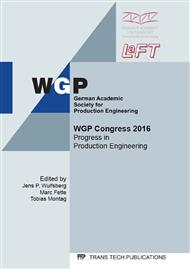[1]
K. Yoshida, Purpose and feature of the Yoshida buckling test, Journal of the Japan Society for Technology of Plasticity, 24 (1983) 901.
Google Scholar
[2]
J. Cao, S.H. Cheng, H.P. Wang, C.T. Wang, Buckling of sheet metals in contact with tool surfaces, Annals of the CIRP, 56/1 (2007) 253-256.
DOI: 10.1016/j.cirp.2007.05.059
Google Scholar
[3]
AutoForm plus R5. 2, Documentation, AutoForm-User Interfaces, Evaluations Stage, Wrinkles.
Google Scholar
[4]
S.P. Timoshenko, J.M. Gere, Theory of elastic stability, United Engineering Trustees, (1936).
Google Scholar
[5]
J.W. Hutchinson, Plastic buckling, Advances in applied mechanics, 14 (1974) 67-144.
Google Scholar
[6]
J.W. Hutchinson, K.W. Neale, Wrinkling of curved thin sheet metal, Plastic Instability Considere Memorial Symposium, Presses Ponts et Chaussees Paris (1985) 71-78.
Google Scholar
[7]
G.T. Nagy, K. Valkering, H. Huetink, Wrinkling criteria in sheet metal forming for single sided contact situation and its application, Int. Conference on Computational Plasticity (2005) 356-369.
Google Scholar
[8]
H.H. Wisselink, G.T. Nagy, T. Meinders, Application of wrinkling criterion for prediction of side-wall wrinkles in deepdrawing of conical cups, IDDRG (2012) 301-306.
Google Scholar
[9]
J.B. Kim, D.Y. Yang, Finite element analysis of the wrinkling initiation and growth in modified Yoshida buckling test, Metals and Materials, 4/4 (1998) 640-647.
DOI: 10.1007/bf03026372
Google Scholar
[10]
J.B. Kim, J.W. Yoon, D.Y. Yang, Wrinkling initiation and growth in modified Yoshida buckling test: Finite element analysis and experimental comparison, Int. Journal of Mechanical Sciences, 42 (2000) 1683-1714.
DOI: 10.1016/s0020-7403(99)00046-6
Google Scholar
[11]
R. Schleich, C. Albiez, A. Papaionanu, Investigation on simulation of buckling of aluminium alloys, 7th European LS-DYNA Conference (2009).
Google Scholar
[12]
M. Liewald, F. Han, A new approach for determination of Wrinkling Limit Curve (WLC) in deep drawing, Forming Technology Forum (2015) 75-80.
Google Scholar
[13]
M. Liewald, F. Han, R. Radonjic, New criterion for prediction of the wrinkle formation in deep drawing process, Key Engineering Materials, 651-653 (2015) 71-76.
DOI: 10.4028/www.scientific.net/kem.651-653.71
Google Scholar
[14]
R. Radonjic, M. Liewald, F. Han, Optimization of the blank holder stiffness in deep drawing processes using FEA, 10th European LS-DYNA Conference (2015).
Google Scholar
[15]
DIN EN ISO 12004-2, Metallische Werkstoffe – Bleche und Bänder – Bestimmung von Grenzformänderungskurven im Labor (2009).
DOI: 10.31030/1443061
Google Scholar
[16]
F. Han, M. Liewald, A new method to enhance the accuracy of the buckling test using modified Yoshida sample, Advanced Materials Research, 1018 (2014) 199-206.
DOI: 10.4028/www.scientific.net/amr.1018.199
Google Scholar


